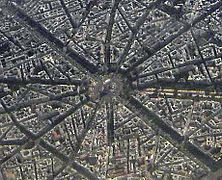space
In the context of urban development, a square or town square is a free area in cities that is usually surrounded by buildings . Squares are often focal points of public life in the city. They are therefore the central theme and spatial element of urban planning .
Central places are the "parlor" of many cities and represent the city lords or citizens . They are therefore usually designed to be particularly complex. Important public buildings such as town halls and churches are often located in central locations. The surrounding buildings have magnificent façades . The square itself is decorated with monuments and fountains , and the flooring is often made of valuable materials.
etymology
The word place goes back to the Middle High German place , plaz and old French place back to vulgar Latin and Latin platea "broad street", "place". This in turn comes from the ancient Greek πλατεία plateia , an abbreviation from πλατεία οδός plateia hodós "broad street". The starting point is the Greek adjective πλατύς platýs "flat", "wide".
history
As long as there are cities, there are also central places where people gather and act . In ancient Greece , the agora was a meeting place for the citizens surrounded by colonnades , lined with temples and decorated with monuments . In Roman architecture , the forum assumed this function. There are also places in the orthogonal street grid of Roman military camps.
Town hall squares can be found in all medieval city plans, mostly in the center of the city walled city. Streets lead from the city gates to this central square. One example is the Rynek Główny in Krakow, which can be reached via the Royal Route .
In the Renaissance and Baroque periods , squares were designed in a more elaborate and sophisticated manner. They have now been planned by well-known architects and laid out with reference to the city plan. Sightlines and perspective distortions played an important role, for example in the Piazza del Campidoglio by Michelangelo or in St. Peter's Square by Gian Lorenzo Bernini in Rome.
According to Camillo custom, unity was common to all traditional European square structures . He found that squares were always oriented towards an outstanding building and that at least when looking at this building, the eye was not guided beyond the perimeter development. Streets never ended in this field of vision in such a way that they formed a visual axis. It is precisely this closeness that defines the quality of historical places for him. In contrast to this, he sees spaces in the block development, which are only areas kept free because of the continuous street routing at the edge and the intersections at the corners.
Since the increase in private transport, squares have become increasingly important as traffic hubs. A well-known example is the Place de la Concorde in Paris, which was laid out as the “Royal Square” and is now dominated by traffic.
Tian'anmen Square in Beijing is often called the largest square . It has an area of 39.6 ha .
Nowadays city planners , landscape architects , architects , traffic planners and artists are concerned with the design of squares.
Typology
- Differentiation according to use :
- Anger , the freely accessible village square as the main shape of the square
- Agora , forum , the ancient square as an urban master form
- Marketplace (example: Nuremberg, main market)
- Parking lot , previously also car stand (example: Munich, Chemnitzer Platz)
- Fairground (example: Munich, Theresienwiese )
- Parade Square (example: Moscow, Red Square )
- Garden square that is mainly frequented by pedestrians
- Schmuckplatz, whose footpaths are mainly in the direction of passenger traffic
- Resting place, recreation area, the footpaths of which are mainly not in the direction of passenger traffic
- Viewpoint (Belvedere) (example: Venice, Piazzetta , an extension of St. Mark's Square )
- Traffic square, located at the confluence of several streets, mainly serving traffic
- Architekturplatz, for the presentation of highlighted buildings :
- Town Hall Square and Court Square
- Church square , also cathedral or cathedral square (example: Rome, St. Peter's Square )
- Schlossplatz , Residenzplatz
- Theater square
- Station forecourt
- playground
- Differentiation according to proportion (i.e. the most important building from a narrow side or a long side determines the square with its height):
- Breitenplatz
- High / low place
Piazza del Duomo in front of the Milan Cathedral
Piazza Navona in Rome (around 1895)
See also
literature
- Lueger, Otto: Lexicon of the entire technology and its auxiliary sciences, Vol. 7 Stuttgart, Leipzig 1909., pp. 157–158. At: zeno.org , accessed on July 6, 2012.
- Places. In: the scales. Journal of Grünenthal GmbH , Volume 36 (pp. 1-45), Aachen 1997, number 1 (with articles by Jürgen Werner, Klaus Semsroth and Kunibert Wachten , Gerwin Zohlen, Sebastian Redecke, Gerhard Ullmann and Wolfgang Becker ).
Web links
Individual evidence
- ↑ See for example Klaus Semsroth, Kunibert Wachten : The neglected habitat. The questionable future of city squares in Europe. In: the scales. Magazine of Grünenthal GmbH, Aachen. Volume 36, 1997, No. 1, pp. 8-14.
- ↑ cf. also Hans Koepf , Günther Binding : Picture Dictionary of Architecture (= Kröner's pocket edition . Volume 194). 4th, revised edition. Kröner, Stuttgart 2005, ISBN 3-520-19404-X , p. 367f.
- ^ Place at Duden online
- ↑ Camillio Sitte: The urban development of his artistic principles . 1898, pp. 36, 92
- ↑ cf. also Camillo Sitte : Urban planning according to its artistic principles . Birkhäuser, Basel 2002. ISBN 3-7643-6692-3 .
- ↑ Piazza: Italian for place.








